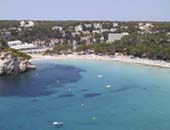Just 25 miles to the north-east of Mallorca, lies the second largest of the Balearic Islands – Menorca (often called Minorca in the UK). Smaller and quieter than its better known neighbour, Menorca has a resident population of just 88,000 and mostly attracts visitors looking for peace and relaxation. Noted for its rugged coastline, Menorca has over 120 beaches, almost as many as Mallorca and Ibiza combined, many are located in secluded coves, well away from the popular resorts, the other big attraction of course is the climate, with the weather being pleasant all year round, with warm dry summers and mild winters.
The main towns of Menorca are the capital Mahon (Mao) and the former capital Ciutadella, Mahon is an attractive town with one of the best natural harbours in the Mediterranean, Ciutadella also has a busy harbour and is very picturesque, with its narrow, winding streets and grand palaces.
Menorca is particularly rich in megalithic structures, which provide evidence of the earliest inhabitants of the Balearic Islands. Possibly settled as early as 4000 BC, a civilisation known as the Talayotic flourished between 2000 and 1000 BC. The Talayots built many stone structures throughout the island, in the form of three main types – Taulas, consisting of 2 stones making a ‘T’ shape, possibly used as altars, Talayots, square or circular rock buildings which could have been dwellings or tombs, and Navetas, in the shape of upturned boats, again possibly used as dwellings.
Menorca and the Balearic Islands were later to become part of the Carthaginian trading empire, recruiting many of the islands famous ‘stone slingers’ into their armies as war approached with Rome. The islanders skill with sling and stone was legendary and it is likely that the name of the island group is derived from the Greek ballein “to throw”.
After the defeat of the Carthaginians by the Romans in the Punic Wars, the islands became an outpost for the Roman Empire, Menorca was renamed Balearis Minor, but seems to have held little importance for the Empire, which had more interest in the mainland. The Romans were replaced by the Goths, who were in turn replaced by the Vandals and the Visigoths, and there was little stability for the island until the arrival of the Moors in the 9th century. Arab rule continued until the 13th century, when Menorca finally came back under Christian control. Menorca and the other Balearic Islands suffered constant attacks by pirates over the following centuries, the fine harbour of Mahon being one of the main targets, in fact this was one of the priorities of the British when they took Menorca in 1708, during the War of Spanish Succession, in the process obtaining the superb harbour for the continued use of the British Royal Navy. Menorca was finally handed back to Spain in 1802 under the Treaty of Amiens. During the Spanish Civil War (1936-39), Menorca remained Republican while its neighbour Mallorca was held by the Nationalists under General Franco.
Menorca today is a popular holiday destination, which has mostly escaped the ravages of mass tourism, its peaceful family resorts and friendly population clinging to their ancient traditions and customs. Lingering British influence from their time there can be seen in the islanders preference for gin as opposed to wine which is normally favoured by the Spanish. The airport is located to the south of the capital Mahon (Mao) and is within easy driving distance of all of the main resorts and tourist centres, it is certainly worth hiring a car, so that you can locate some of the more out of the way beaches and also take a look at some of the best historical sites. Menorca Map.

